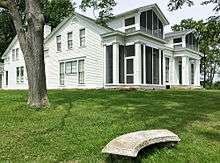Indiana Landmarks




Indiana Landmarks is America's largest private statewide historic preservation organization. Founded in 1960 as Historic Landmarks Foundation of Indiana by a volunteer group of civic and business leaders led by Indianapolis pharmaceutical executive Eli Lilly, the organization is a private non-governmental organization with nearly 6,000 members and an endowment of over $40-million.[1] The organization simplified its name to Indiana Landmarks in 2010.
Indiana Landmarks owns and restores historic buildings, buys and sells vacant and endangered property, and helps people throughout Indiana save and restore historic places through a variety of programs including grants, loans, and advocacy.
Indiana Landmarks employs staff at its state headquarters in Indianapolis and in regional offices throughout the state of Indiana. Regional offices are located in South Bend, Hobart, Jeffersonville, Aurora, Evansville, Cambridge City and Terre Haute. The organization's state headquarters are located at the former Central Avenue United Methodist Church in Indianapolis, now known as Indiana Landmarks Center. In addition to Indiana Landmarks Center, Indiana Landmarks owns and operates three historic properties as event and rental venues: the Morris-Butler House in Indianapolis, the Huddleston Farmhouse Inn Museum in Cambridge City, Indiana, and Veraestau historic site in Aurora, Indiana. Landmarks' honorary board chair is Indiana's former Chief Justice Randall T. Shepard.[1]
The organization's first project was restoration of the 1865 Morris-Butler House in Indianapolis. Eli Lilly personally underwrote the acquisition and restoration of the house as a museum of Victorian decorative arts. Though the Morris-Butler House no longer operates as a museum, it is part of the Indiana Landmarks Center campus and functions as an event and rental facility.
One of Indiana Landmarks' largest projects was the $30-million+ restoration of the West Baden Springs Hotel's exterior and public spaces. Indiana Landmarks helped lead the effort to bring riverboat gaming to Orange County, Indiana as a way to revitalize the French Lick Resort Casino and the West Baden Springs Hotel.
New name, headquarters
In April 2010, in conjunction with the organization's 50th anniversary, Indiana Landmarks announced its name change from Historic Landmarks Foundation of Indiana. At the same time, it announced that medical device entrepreneur Bill Cook and his wife, Gayle pledged $17-million to renovate the former Central Avenue United Methodist Church at 12th Street and Central Avenue in the Old Northside Historic District of Indianapolis as a performance space and new headquarters for the organization, to be known as Indiana Landmarks Center.
Endangered Landmarks
Each May (National Historic Preservation Month), Indiana Landmarks announces a list of the state's 10 Most Endangered landmarks. Circumstances that land properties among the 10 Most Endangered generally involve one or more of the following factors: demolition threat, abandonment, neglectful owner, dilapidation, obsolete use, lack of money for repairs, unreasonable above-market sale price, out-of-the-way location, or encroaching sprawl. Indiana Landmarks uses the 10 Most Endangered list to bring public attention to the imperiled sites and mobilize support for their preservation.
2015 Ten Most Endangered List [2]
- Bedford Elks Building, Bedford
- Camp Chesterfield, Chesterfield
- First Presbyterian Church & Lafayette Building, South Bend
- Indiana County Homes
- Indiana Medical History Museum, Indianapolis
- IOOF United Brethren Block, Huntington
- McCurdy Hotel, Evansville
- McDonald House, Attica
- Mills House, Greenwood
- Rivoli Theater, Indianapolis
References
- 1 2 The Encyclopedia of Indianapolis By David J. Bodenhamer, Robert Graham Barrows, David Gordon Vanderstel, pg 685
- ↑ "Indiana Landmarks - 10 Most Endangered landmarks in Indiana". www.indianalandmarks.org. Retrieved 2016-01-05. horizontal tab character in
|title=at position 21 (help)
Further reading
- The Encyclopedia of Indianapolis David J. Bodenhamer, Robert Graham Barrows, David Gordon Vanderstel
External links
| Wikimedia Commons has media related to Landmarks in Indiana. |